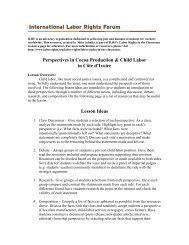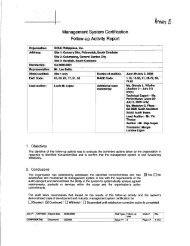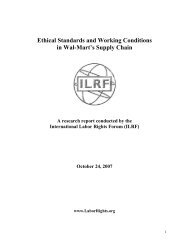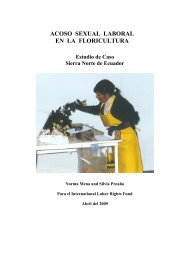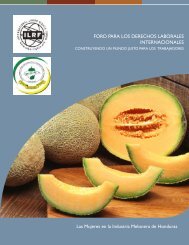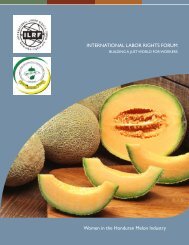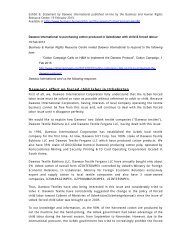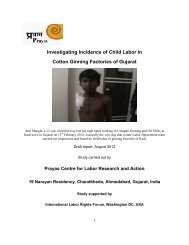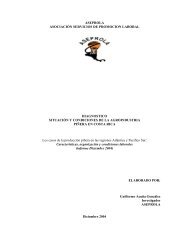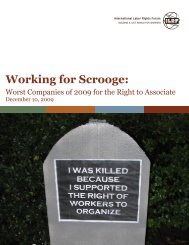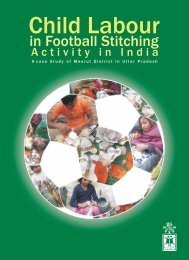Child Labor in the Soccer Ball Industry - International Labor Rights ...
Child Labor in the Soccer Ball Industry - International Labor Rights ...
Child Labor in the Soccer Ball Industry - International Labor Rights ...
You also want an ePaper? Increase the reach of your titles
YUMPU automatically turns print PDFs into web optimized ePapers that Google loves.
<strong>Child</strong> <strong>Labor</strong> <strong>in</strong> <strong>the</strong> <strong>Soccer</strong> <strong>Ball</strong> <strong>Industry</strong><br />
A Report on Cont<strong>in</strong>ued Use of <strong>Child</strong> <strong>Labor</strong> <strong>in</strong> <strong>the</strong> <strong>Soccer</strong> <strong>Ball</strong> <strong>Industry</strong> <strong>in</strong> Pakistan<br />
Highlights of <strong>the</strong> Report<br />
<strong>International</strong> <strong>Labor</strong> <strong>Rights</strong> Fund<br />
February, 1999<br />
In 1996, we first called attention to <strong>the</strong> bonded child laborers produc<strong>in</strong>g soccer balls for <strong>the</strong> world market<br />
<strong>in</strong> Sialkot, Pakistan. These children, often work<strong>in</strong>g <strong>in</strong> debt servitude, were produc<strong>in</strong>g balls carry<strong>in</strong>g<br />
major labels like Challenge, Baden, Nike and Adidas. In response to <strong>the</strong> exposes, soccer ball<br />
manufacturers agreed to participate <strong>in</strong> a monitor<strong>in</strong>g program sponsored by <strong>the</strong> ILO. The program had <strong>the</strong><br />
stated goal of elim<strong>in</strong>at<strong>in</strong>g child labor from <strong>the</strong> soccer ball <strong>in</strong>dustry <strong>in</strong> Pakistan with<strong>in</strong> 18 months. The<br />
program <strong>in</strong>tended to provide former child workers with educational opportunities, so that <strong>the</strong>y were not<br />
simply forced to work <strong>in</strong> ano<strong>the</strong>r <strong>in</strong>dustry.<br />
Now, a year <strong>in</strong>to <strong>the</strong> program, <strong>in</strong>dependent researchers have discovered that child labor persists <strong>in</strong> <strong>the</strong><br />
Sialkot soccer ball <strong>in</strong>dustry. Moreover, even accord<strong>in</strong>g to <strong>the</strong> ILO's own assessment of <strong>the</strong> program, it is<br />
beset with a number ofproblems. These <strong>in</strong>clude:<br />
Many manufacturers who signed onto <strong>the</strong> program have not paid dues or provided any details<br />
about <strong>the</strong>ir stitch<strong>in</strong>g centers.<br />
Even participat<strong>in</strong>g employers are still us<strong>in</strong>g children <strong>in</strong> <strong>the</strong>ir stitch<strong>in</strong>g centers, and <strong>in</strong> home-based<br />
employment; <strong>the</strong> ILO is not empowered to apply any sanctions to <strong>the</strong>se employers.<br />
• <strong>Soccer</strong> ball production may be shift<strong>in</strong>g from Sialkot to nearby, unregulated regions ofPakistan,<br />
and some children may be mov<strong>in</strong>g from production of soccer balls to production of surgical<br />
<strong>in</strong>struments.<br />
• Schools established for soccer-stitch<strong>in</strong>g children may <strong>in</strong>stead be serv<strong>in</strong>g o<strong>the</strong>r children, while<br />
former soccer stitchers are employed <strong>in</strong> o<strong>the</strong>r work.<br />
In short, we are deeply concerned that soccer ball manufacturers and retailers may be us<strong>in</strong>g <strong>the</strong>ir<br />
participation <strong>in</strong> <strong>the</strong> program to claim <strong>the</strong>ir balls are "child labor free," without actually tak<strong>in</strong>g sufficient<br />
steps to remove children from <strong>the</strong> production process.<br />
Despite <strong>the</strong>se problems, <strong>the</strong> ILO is plann<strong>in</strong>g to expand <strong>the</strong> program to <strong>the</strong> soccer ball <strong>in</strong>dustry <strong>in</strong> India<br />
and <strong>in</strong>itiate a similar program <strong>in</strong> <strong>the</strong> carpet <strong>in</strong>dustry <strong>in</strong> Pakistan. We feel it would be a mistake to expand<br />
<strong>the</strong> program to ano<strong>the</strong>r country or to ano<strong>the</strong>r <strong>in</strong>dustry before it has been able to achieve its goal of<br />
elim<strong>in</strong>at<strong>in</strong>g child labor from <strong>the</strong> Pakistan soccer ball <strong>in</strong>dustry. We encourage <strong>the</strong> ILO to address <strong>the</strong><br />
problems identified <strong>in</strong> this report before endors<strong>in</strong>g a s<strong>in</strong>gle manufacturer or expand<strong>in</strong>g <strong>the</strong><br />
<strong>in</strong>itiative <strong>in</strong> any way.<br />
Introduction
In 1996, <strong>the</strong> <strong>International</strong> <strong>Labor</strong> <strong>Rights</strong> Fund (ILRF) began a campaign called "Foul <strong>Ball</strong>" to call<br />
attention to <strong>the</strong> plight of thousands of children work<strong>in</strong>g full time to stitch soccer balls for <strong>the</strong> world<br />
market <strong>in</strong> villages <strong>in</strong> <strong>the</strong> Sialkot region of Pakistan. Some of <strong>the</strong>se children were work<strong>in</strong>g <strong>in</strong> debt<br />
bondage. The campaign mobilized soccer players and consumers of soccer balls around <strong>the</strong> world, and<br />
led to <strong>the</strong> establishment of an <strong>in</strong>ternational program to elim<strong>in</strong>ate child labor from <strong>the</strong> Pakistani soccer ball<br />
<strong>in</strong>dustry and to establish schools to ensure that <strong>the</strong>se children received an education. The <strong>in</strong>itiative was<br />
organized by <strong>the</strong> <strong>International</strong> <strong>Labor</strong> Organization (ILO), <strong>the</strong> United Nations <strong>Child</strong>ren's Fund (UNICEF),<br />
Save <strong>the</strong> <strong>Child</strong>ren (UK) and <strong>the</strong> Sialkot Chamber of Commerce and <strong>Industry</strong> (SCCI) <strong>in</strong> December, 1997 .<br />
Now, one year later, ILRF's <strong>in</strong>dependent research f<strong>in</strong>d<strong>in</strong>gs <strong>in</strong>dicate that <strong>the</strong> use of child labor <strong>in</strong> this<br />
<strong>in</strong>dustry persists. The report below details our new f<strong>in</strong>d<strong>in</strong>gs and summarizes <strong>the</strong> mid-term report of <strong>the</strong><br />
ILO on <strong>the</strong> progress of its <strong>in</strong>itiative.<br />
Background<br />
<strong>Soccer</strong>, or "football" as it is known <strong>in</strong> most countries, is <strong>the</strong> world's most popular sport. It is played by<br />
millions of people worldwide. Not surpris<strong>in</strong>gly, <strong>the</strong> soccer ball <strong>in</strong>dustry is a multimillion dollar <strong>in</strong>dustry.<br />
Most of <strong>the</strong> world's soccer balls are produced <strong>in</strong> <strong>the</strong> Sialkot region of Pakistan. Pakistan alone accounts<br />
for 75 percent of total world production of soccer balls, and 71 percent of all soccer ball imports <strong>in</strong>to <strong>the</strong><br />
United States. The rema<strong>in</strong>der ofproduction occurs mostly <strong>in</strong> Ch<strong>in</strong>a, India and Indonesia. No soccer balls<br />
are manufactured <strong>in</strong> <strong>the</strong> United States.<br />
Pakistan is a country with a population of 140 million people. Forty-one percent of <strong>the</strong> population are<br />
age 15 or younger. The country's economy is largely based on agriculture, and approximately 50 percent<br />
of <strong>the</strong> population are employed <strong>in</strong> <strong>the</strong> agricultural sector. One-third of <strong>the</strong> population live <strong>in</strong> absolute<br />
poverty accord<strong>in</strong>g to <strong>the</strong> United Nations Development Programme (UNDP).<br />
The Sialkot region ofPakistan has been famous for produc<strong>in</strong>g soccer balls for at least 80 years. It is<br />
estimated that <strong>the</strong>re are about 10,000 urban workers and 30,000 rural workers <strong>in</strong> <strong>the</strong> 1,450 villages of<br />
Sialkot <strong>in</strong>volved <strong>in</strong> <strong>the</strong> production of soccer balls.<br />
Although some balls are mach<strong>in</strong>e-made, <strong>the</strong> best soccer balls are hand-stitched. Hand-stitch<strong>in</strong>g <strong>the</strong><br />
panels of a ball toge<strong>the</strong>r is a very labor-<strong>in</strong>tensive process and is where children have been found work<strong>in</strong>g.<br />
Stitchers sew toge<strong>the</strong>r <strong>the</strong> panels of a soccer ball and glue <strong>in</strong> <strong>the</strong> <strong>in</strong>flatable bladder. They are employed by<br />
subcontractors, typically on a piece rate basis, and may work <strong>in</strong> a stitch<strong>in</strong>g center, small village<br />
workshop, or <strong>in</strong> homes.<br />
In 1996, an ILO study <strong>in</strong> <strong>the</strong> Sialkot region estimated that more than 7,000 Pakistani children between <strong>the</strong><br />
ages of 5 and 14 stitched balls on a regular, full-time basis; some worked as long as 10 to 11 hours a day.<br />
In addition, large numbers of children worked part-time outside of school hours. On average, <strong>the</strong>se<br />
children were paid between 20 to 22 Pakistani rupees per ball, or about $0.50 to $0.55. The average<br />
worker can stitch two or three balls per day. Independent local activists found that many of <strong>the</strong>se<br />
children were work<strong>in</strong>g <strong>in</strong> bondage to <strong>the</strong>ir employers to pay off <strong>the</strong>ir parents' debts. Thus, <strong>the</strong>y and <strong>the</strong>ir<br />
families were unable to escape <strong>the</strong>ir labor obligations, and <strong>the</strong> children were unable to attend school,<br />
ensur<strong>in</strong>g that as adults <strong>the</strong>y would cont<strong>in</strong>ue to suffer <strong>in</strong> poverty and possible cont<strong>in</strong>ued debt bondage.<br />
The ILO Initiative<br />
Adverse publicity <strong>in</strong> <strong>the</strong> United States and Europe about children stitch<strong>in</strong>g soccer balls prompted action<br />
by soccer ball retailers and by concerned activists to ensure that balls were produced without child labor.<br />
In September, 1996 <strong>the</strong> <strong>International</strong> Federation of Football Associations (FIFA), <strong>the</strong> world regulatory<br />
agency for soccer, adopted a Code of <strong>Labor</strong> Practice for all manufacturers of balls carry<strong>in</strong>g <strong>the</strong> FIFA
label. FIFA already had a program of quality control <strong>in</strong> place to certify and label all balls used <strong>in</strong><br />
<strong>in</strong>ternational tournament play. The organization collaborated with three trade union bodies: <strong>the</strong><br />
<strong>International</strong> Confederation ofFree Trade Unions (ICFTU), <strong>the</strong> <strong>International</strong> Textile, Garment and<br />
Lea<strong>the</strong>r Workers Federation (ITGLWF), and <strong>the</strong> <strong>International</strong> Federation of Commercial, Clerical, and<br />
Technical Employees(FIET) to develop a comprehensive code of labor practice to be added to <strong>the</strong> quality<br />
control criteria for all goods bear<strong>in</strong>g its logo. The code not only prohibited <strong>the</strong> use of child labor, but also<br />
guaranteed workers' rights to organize and to barga<strong>in</strong> collectively, to fair and safe work<strong>in</strong>g conditions,<br />
and to several o<strong>the</strong>r protections.<br />
Unsurpris<strong>in</strong>gly, this code attracted considerable anxiety and animosity from <strong>the</strong> World Federation of<br />
Sport<strong>in</strong>g Goods Industries (WFSGI) when it was announced, lead<strong>in</strong>g to <strong>the</strong> formulation of a WFSGI<br />
Code, and to an effort to limit damage to <strong>the</strong> <strong>in</strong>dustry by a program to elim<strong>in</strong>ate child labor from <strong>the</strong><br />
mak<strong>in</strong>g of soccer balls <strong>in</strong> Sialkot. This program was negotiated between <strong>the</strong> ILO, UNICEF, Save The<br />
<strong>Child</strong>ren (UK), and <strong>the</strong> Sialkot Chamber of Commerce and <strong>Industry</strong>, represent<strong>in</strong>g soccer factories. On<br />
February 14, 1997, <strong>in</strong> Atlanta, Georgia, representatives of all <strong>the</strong>se organizations signed <strong>the</strong> Partners'<br />
Agreement to Elim<strong>in</strong>ate <strong>Child</strong> Labour <strong>in</strong> <strong>the</strong> <strong>Soccer</strong> <strong>Industry</strong> <strong>in</strong> Pakistan. The program <strong>in</strong>tended to<br />
elim<strong>in</strong>ate child labor from <strong>the</strong> soccer ball <strong>in</strong>dustry with<strong>in</strong> 18 months, through <strong>the</strong> creation ofnew<br />
opportunities for children with an emphasis on education and tra<strong>in</strong><strong>in</strong>g. As a result of<strong>the</strong> Atlanta<br />
Agreement on child labor, <strong>the</strong> more complete FIFA code has never been implemented or subjected to<br />
monitor<strong>in</strong>g.<br />
The ILRF Research F<strong>in</strong>d<strong>in</strong>gs<br />
The ILO program began <strong>in</strong> late 1997. In late 1998, <strong>the</strong> Association ofNetwork for Community<br />
Empowerment (ANCE), based <strong>in</strong> Lahore, Pakistan, conducted an <strong>in</strong>dependent <strong>in</strong>vestigation <strong>in</strong>to <strong>the</strong><br />
effectiveness of <strong>the</strong> ILO program. A research team visited 23 villages <strong>in</strong> <strong>the</strong> Sialkot region to determ<strong>in</strong>e<br />
whe<strong>the</strong>r or not children cont<strong>in</strong>ued to work on soccer ball production ei<strong>the</strong>r with<strong>in</strong> village stitch<strong>in</strong>g centers<br />
or at home, and whe<strong>the</strong>r new educational opportunities had been offered to <strong>the</strong>se children through <strong>the</strong><br />
ILO program. The team not only found that children cont<strong>in</strong>ued to work <strong>in</strong> stitch<strong>in</strong>g centers <strong>in</strong> <strong>the</strong>se<br />
villages, but also heard reports that a number of children had been shifted from soccer ball production to<br />
<strong>the</strong> production of surgical <strong>in</strong>struments. The majority of child workers <strong>in</strong>terviewed had never attended any<br />
educational <strong>in</strong>stitution.<br />
The <strong>in</strong>vestigation was conducted between August and October, 1998. The ANCE researchers were<br />
known to ILRF as <strong>in</strong>dividuals with a history ofactivism on child welfare issues. The team <strong>in</strong>terviewed<br />
adult workers, child workers and residents of <strong>the</strong> villages, as well as factory owners, local officials and<br />
ILO monitor<strong>in</strong>g team officials. The research team visited 23 village stitch<strong>in</strong>g centers, selected at random<br />
out of several hundred <strong>in</strong> <strong>the</strong> region. Out of<strong>the</strong>se 23, <strong>the</strong>y found child workers present <strong>in</strong> eight centers.<br />
The adult workers were asked about <strong>the</strong> absence of children from <strong>the</strong> stitch<strong>in</strong>g centers where children<br />
were not present. They <strong>in</strong>formed <strong>the</strong> researchers that <strong>the</strong> production of soccer balls was seasonal, and<br />
that <strong>the</strong>y were <strong>in</strong> <strong>the</strong> slow season. They <strong>in</strong>dicated that dur<strong>in</strong>g peak season it was more likely that children<br />
would be brought <strong>in</strong>to <strong>the</strong> centers, or that excess production would be outsourced to children <strong>in</strong> homes.<br />
Dur<strong>in</strong>g <strong>the</strong> slow season for soccer balls, <strong>the</strong>y stated that children are often sent to work <strong>in</strong> <strong>the</strong> surgical<br />
<strong>in</strong>struments <strong>in</strong>dustry.<br />
The adults were asked about <strong>the</strong> presence ofILO monitors <strong>in</strong> <strong>the</strong> region. They responded that <strong>the</strong> system<br />
of deploy<strong>in</strong>g ILO monitors has unwitt<strong>in</strong>gly created an "early warn<strong>in</strong>g" system for employers. S<strong>in</strong>ce <strong>the</strong><br />
ILO monitors are residents of<strong>the</strong> local communities, <strong>the</strong>y are known not only to employers but to most<br />
local residents. Interviewees told researchers that employers are very often "tipped off' when <strong>the</strong><br />
monitor is en route to <strong>the</strong> stitch<strong>in</strong>g center, and are able to hide <strong>the</strong> child workers. Fur<strong>the</strong>rmore, adult<br />
workers noted that some stitch<strong>in</strong>g has been shifted from <strong>the</strong> centers to private homes, to which <strong>the</strong>
monitors do not have access.<br />
Ano<strong>the</strong>r problem noted by local <strong>in</strong>habitants was <strong>the</strong> relocation of stitch<strong>in</strong>g centers. Because <strong>the</strong> ILO<br />
project has targeted <strong>the</strong> region of Sialkot, some manufacturers have relocated to o<strong>the</strong>r nearby districts, out<br />
of <strong>the</strong> jurisdiction of <strong>the</strong> ILO <strong>in</strong>spectors.<br />
The research team noted that <strong>the</strong> ILO project was <strong>in</strong>tended to rehabilitate child workers through <strong>the</strong><br />
establishment of educational facilities. However, no educational centers were found <strong>in</strong> any of <strong>the</strong> 23<br />
villages visited.<br />
F<strong>in</strong>ally, ILRF has learned from ano<strong>the</strong>r <strong>in</strong>dependent NGO observer that although 36 manufacturers have<br />
signed onto <strong>the</strong> Atlanta Agreement, to date only 16 have paid <strong>the</strong>ir dues and submitted <strong>in</strong>formation about<br />
<strong>the</strong>ir stitch<strong>in</strong>g centers. In short, more than half <strong>the</strong> "participants" <strong>in</strong> this program appear to be free riders,<br />
benfitt<strong>in</strong>g from <strong>the</strong> positive publicity around <strong>the</strong> ILO program without tak<strong>in</strong>g a s<strong>in</strong>gle step to elim<strong>in</strong>ate<br />
child labor from <strong>the</strong>ir facilities!<br />
The ILO Mid-Term Assessment<br />
The ILO has issued its own mid-term assessment of its monitor<strong>in</strong>g project. The review was completed <strong>in</strong><br />
November 1998, after <strong>the</strong> program had been <strong>in</strong> place for one year. With six months to go, <strong>the</strong> ILO<br />
reports that <strong>the</strong> program has had <strong>the</strong> follow<strong>in</strong>g successes:<br />
• The total number of manufacturers participat<strong>in</strong>g <strong>in</strong> <strong>the</strong> program has expanded from 22 to 36.<br />
However <strong>the</strong> ILO report notes that this represents only half of all soccer ball manufacturers <strong>in</strong> <strong>the</strong><br />
Sialkot region, and only about 65 - 70 percent of all production for export from <strong>the</strong> region.<br />
• Fifty percent of all manufacturers participat<strong>in</strong>g <strong>in</strong> <strong>the</strong> program (e.g. 18 manufacturers) have<br />
shifted production to stitch<strong>in</strong>g centers monitored by <strong>the</strong> ILO. The ILO report notes that <strong>the</strong><br />
rema<strong>in</strong><strong>in</strong>g participat<strong>in</strong>g manufacturers cont<strong>in</strong>ue to outsource some production to children<br />
work<strong>in</strong>g at home.<br />
• The program is currently monitor<strong>in</strong>g 379 stitch<strong>in</strong>g centers, and will beg<strong>in</strong> monitor<strong>in</strong>g an<br />
additional 80 women-only stitch<strong>in</strong>g centers. There are 15 monitors who operate <strong>in</strong> teams of two<br />
and conduct "regular, unannounced visits" to <strong>the</strong> centers. The ILO report states that 163 children<br />
have been found at work <strong>in</strong> <strong>the</strong> centers s<strong>in</strong>ce <strong>the</strong> program began, and that "many" of<strong>the</strong>se<br />
children have been removed from <strong>the</strong> workplace and given educational opportunities.<br />
• Approximately 5400 children are attend<strong>in</strong>g education centers established under <strong>the</strong> program. The<br />
program has established 154 non-formal education centers. The report notes that many of <strong>the</strong><br />
children attend<strong>in</strong>g <strong>the</strong> centers cont<strong>in</strong>ue to work part-time as soccer ball stitchers at home.<br />
Recommendations for Action<br />
ILRF recognizes that <strong>the</strong> problem of elim<strong>in</strong>at<strong>in</strong>g child labor from any <strong>in</strong>dustry is a difficult one, and that<br />
<strong>the</strong> 18-month time frame agreed to <strong>in</strong> <strong>the</strong> 1997 Partners' Agreement may be <strong>in</strong>sufficient to deal with this<br />
task. We commend <strong>the</strong> ILO program for hav<strong>in</strong>g established new educational opportunities for children <strong>in</strong><br />
<strong>the</strong> Sialkot area and we hope <strong>the</strong>se opportunities can be expanded. However, we are concerned by <strong>the</strong><br />
f<strong>in</strong>d<strong>in</strong>gs of <strong>the</strong> ANCE report. We believe that <strong>in</strong> order to be truly effective, <strong>the</strong> ILO monitor<strong>in</strong>g program<br />
must address concerns raised <strong>in</strong> this report. Weare particularly concerned that <strong>the</strong> ILO is now plann<strong>in</strong>g<br />
to expand this <strong>in</strong>itiative to India. We feel it would be irresponsible of <strong>the</strong> parties <strong>in</strong>volved to expand <strong>the</strong><br />
program to ano<strong>the</strong>r country without first address<strong>in</strong>g <strong>the</strong> serious problems <strong>in</strong>herent <strong>in</strong> <strong>the</strong> current <strong>in</strong>itiative.
We also note that issues raised not only by <strong>the</strong> ANCE report, but also by <strong>the</strong> ILO mid-term assessment,<br />
suggest that many manufacturers who have signed on to <strong>the</strong> program are still us<strong>in</strong>g child labor. At least<br />
half <strong>the</strong> manufacturers who entered <strong>the</strong> agreement have not taken any steps to elim<strong>in</strong>ate children from <strong>the</strong><br />
production process. Stronger actions may be <strong>the</strong>refore be needed to br<strong>in</strong>g <strong>the</strong>se manufacturers, and <strong>the</strong><br />
retailers <strong>the</strong>y supply, to a more wholehearted commitment to elim<strong>in</strong>ate child labor. Also, many<br />
manufacturers <strong>in</strong> <strong>the</strong> region are not even part of <strong>the</strong> agreement, fur<strong>the</strong>r underm<strong>in</strong><strong>in</strong>g <strong>the</strong> ability of <strong>the</strong><br />
program to elim<strong>in</strong>ate child labor from <strong>the</strong> <strong>in</strong>dustry.<br />
We would like to highlight <strong>the</strong> follow<strong>in</strong>g problems with <strong>the</strong> ILO program:<br />
• Unregulated soccer ball production <strong>in</strong> nearby districts. Some manufactur<strong>in</strong>g of soccer balls is<br />
be<strong>in</strong>g shifted away from Sialkot to o<strong>the</strong>r districts where no monitor<strong>in</strong>g exists. Manufacturers<br />
who claim to be participat<strong>in</strong>g <strong>in</strong> <strong>the</strong> ILO program should not be allowed to make such claims if<br />
<strong>the</strong>y are <strong>in</strong> fact shift<strong>in</strong>g production to o<strong>the</strong>r locales. Participat<strong>in</strong>g manufacturers should be<br />
required to make available to all partners <strong>in</strong> <strong>the</strong> Partners' Agreement, as well as to <strong>the</strong> ILO<br />
monitor<strong>in</strong>g team, a complete list of production facilities both with<strong>in</strong> and without <strong>the</strong> Sialkot<br />
regIOn.<br />
• Cont<strong>in</strong>ued use ofchildren by participat<strong>in</strong>g employers. We are disturbed by <strong>the</strong> fact that some of<br />
<strong>the</strong> participat<strong>in</strong>g manufacturers are cont<strong>in</strong>u<strong>in</strong>g to use home based child labor, even after sign<strong>in</strong>g<br />
<strong>the</strong> Partners' Agreement. This signals that <strong>the</strong> manufacturers are not truly committed to<br />
elim<strong>in</strong>at<strong>in</strong>g child labor. We understand that <strong>the</strong>se manufacturers have committed to eventual<br />
shift<strong>in</strong>g of production to ILO-monitored centers, but see no reason why <strong>the</strong>y should cont<strong>in</strong>ue to<br />
use children <strong>in</strong> <strong>the</strong> <strong>in</strong>terval. The manufacturers should be required to provide names and<br />
addresses of <strong>in</strong>dividuals to whom stitch<strong>in</strong>g is be<strong>in</strong>g outsourced, so that ILO monitors can visit<br />
homes <strong>in</strong> which production is occurr<strong>in</strong>g and verify that children are not <strong>in</strong>volved with production.<br />
• Failure of<strong>the</strong> <strong>in</strong>spectors to remove identified childworkersfrom <strong>the</strong> <strong>in</strong>dustry. We are concerned<br />
by <strong>the</strong> fact that <strong>the</strong> program appears to have identified work<strong>in</strong>g children both through<br />
<strong>in</strong>vestigations of stitch<strong>in</strong>g centers, and also through its <strong>in</strong>formal education centers, but that steps<br />
have not yet been taken to remove <strong>the</strong>se children from <strong>the</strong> <strong>in</strong>dustry. The report notes that several<br />
children attend<strong>in</strong>g <strong>the</strong> education centers are also stitch<strong>in</strong>g balls at home part-time. While we<br />
understand that it may be difficult to remove a source of <strong>in</strong>come from poor families before o<strong>the</strong>r<br />
economic opportunities have been established for <strong>the</strong>m, never<strong>the</strong>less we are very concerned that<br />
consumers <strong>in</strong> <strong>the</strong> United States and elsewhere are be<strong>in</strong>g misled <strong>in</strong>to believ<strong>in</strong>g that participants <strong>in</strong><br />
<strong>the</strong> Partners' Agreement have actually ceased to use child labor, whereas it is evident that <strong>the</strong>y<br />
have no immediate <strong>in</strong>tention to do so.<br />
• No clear role for local activists. F<strong>in</strong>ally we th<strong>in</strong>k it is important that local advocacy groups like<br />
ANCE be encouraged to take on a role <strong>in</strong> "monitor<strong>in</strong>g <strong>the</strong> monitors." We note that <strong>the</strong> ILO is not<br />
simply a workers' advocacy organization, but ra<strong>the</strong>r a tripartite <strong>in</strong>stitution with responsibilities<br />
not only to workers but equally to governments and to employers. We note fur<strong>the</strong>r that local<br />
employers are a major partner to <strong>the</strong> exist<strong>in</strong>g agreement, and that this may have limited <strong>the</strong> scope<br />
of <strong>the</strong> program. Although Save <strong>the</strong> <strong>Child</strong>ren (UK) is a formal partner to <strong>the</strong> program, <strong>the</strong>re<br />
appears to be no role for local labor or child welfare advocates (with <strong>the</strong> exception ofBunyad, an<br />
organization with close ties to <strong>the</strong> Pakistani government) <strong>in</strong> assess<strong>in</strong>g <strong>the</strong> usefulness of <strong>the</strong><br />
program to <strong>the</strong>ir goals. We suggest that <strong>the</strong>re is a need for ongo<strong>in</strong>g, impartial evaluation of <strong>the</strong><br />
program by <strong>in</strong>dependent NGOs <strong>in</strong> order to ensure that it is of use to local communities, and to<br />
assure consumers <strong>in</strong> o<strong>the</strong>r countries that children do not cont<strong>in</strong>ue to suffer from exploitation by<br />
manufacturers.
We <strong>the</strong>refore encourage <strong>the</strong> ILO monitors to <strong>in</strong>vestigate and to develop action plans to deal with <strong>the</strong><br />
issues raised by <strong>the</strong> ANCE report. We note that <strong>the</strong> ILO has noted its <strong>in</strong>tention to address one problem<br />
raised by <strong>the</strong> report: <strong>the</strong> f<strong>in</strong>d<strong>in</strong>g that children may be shifted from soccer ball production to work <strong>in</strong> <strong>the</strong><br />
equally hazardous surgical <strong>in</strong>struments <strong>in</strong>dustry. The ILO mid-term assessment notes that <strong>the</strong> program<br />
may be expanded to <strong>the</strong> surgical <strong>in</strong>struments <strong>in</strong>dustry. We encourage <strong>the</strong> program to <strong>in</strong>vestigate<br />
immediately <strong>the</strong> presence of children <strong>in</strong> <strong>the</strong> surgical <strong>in</strong>struments <strong>in</strong>dustry as a basis for develop<strong>in</strong>g plans<br />
to monitor this <strong>in</strong>dustry.<br />
We note that <strong>the</strong> ILO mid-term assessment report itself suggested a stronger need for sanctions aga<strong>in</strong>st<br />
non-compliant manufacturers with<strong>in</strong> <strong>the</strong> program. We encourage <strong>the</strong> partners to revisit <strong>the</strong> Partners'<br />
Agreement, and to streng<strong>the</strong>n it to <strong>in</strong>clude sanctions aga<strong>in</strong>st manufacturers with<strong>in</strong> <strong>the</strong> program who fail to<br />
comply with its commitments to cease employ<strong>in</strong>g children. Fur<strong>the</strong>rmore, we encourage <strong>the</strong> ILO to<br />
refra<strong>in</strong> from grant<strong>in</strong>g any manufacturer a statement of compliance or participation <strong>in</strong> <strong>the</strong> program unless<br />
and until all child labor <strong>in</strong> <strong>the</strong> company's production has been stopped.<br />
We encourage concerned citizens and consumers to take <strong>the</strong> follow<strong>in</strong>g actions:<br />
• Write to soccer ball retailers who have endorsed <strong>the</strong> program (a list follows) to <strong>in</strong>sist that <strong>the</strong>ir<br />
manufacturers take part <strong>in</strong> this program, and that <strong>the</strong>y upgrade efforts to elim<strong>in</strong>ate child labor. A<br />
sample letter follows.<br />
• Write to <strong>the</strong> ILO to encourage <strong>the</strong>m to respond to <strong>the</strong> issues raised here and to streng<strong>the</strong>n and<br />
expand <strong>the</strong>ir monitor<strong>in</strong>g program; and most importantly, to consult regularly with local activists<br />
to make sure <strong>the</strong> program is respond<strong>in</strong>g to <strong>the</strong>ir concerns. Encourage <strong>the</strong> ILO to suspend its<br />
plans to extend <strong>the</strong> program to India until it has succeeded <strong>in</strong> elim<strong>in</strong>at<strong>in</strong>g child labor <strong>in</strong> Pakistan.<br />
A sample letter follows.<br />
Sample letter to soccer ball retailers:<br />
Dear<br />
With this letter, I would like to express my deep concern over <strong>the</strong> use of child labor <strong>in</strong> <strong>the</strong> soccer ball<br />
<strong>in</strong>dustry. In Pakistan, where most soccer balls are produced, young children are be<strong>in</strong>g denied education<br />
and <strong>in</strong> some cases work<strong>in</strong>g <strong>in</strong> debt servitude to produce soccer balls for <strong>the</strong> US market. I would like to<br />
urge you to take steps to ensure that your company is not retail<strong>in</strong>g soccer balls made with child labor.<br />
The <strong>International</strong> <strong>Labor</strong> Organization has established a program to elim<strong>in</strong>ate child labor from soccer ball<br />
production <strong>in</strong> Pakistan. However, not all soccer ball manufacturers are participat<strong>in</strong>g <strong>in</strong> <strong>the</strong> program, and<br />
not all participat<strong>in</strong>g manufacturers have elim<strong>in</strong>ated children from <strong>the</strong> production process. Therefore I<br />
would like to urge you to contact your suppliers <strong>in</strong> Pakistan. If <strong>the</strong>y are not members of <strong>the</strong> ILO<br />
program, you should <strong>in</strong>sist that <strong>the</strong>y participate <strong>in</strong> <strong>the</strong> program, or else consider sourc<strong>in</strong>g from a<br />
manufacturer that does participate <strong>in</strong> <strong>the</strong> program. If your suppliers do participate <strong>in</strong> <strong>the</strong> program, you<br />
should <strong>in</strong>sist that <strong>the</strong>y pay <strong>the</strong>ir full dues to <strong>the</strong> program, and also that <strong>the</strong>y provide a complete list of <strong>the</strong>ir<br />
production facilities to <strong>the</strong> ILO <strong>in</strong>spection team.<br />
Thank you for your attention.<br />
S<strong>in</strong>cerely,<br />
(Your name)
Sample letter to <strong>the</strong> ILO:<br />
Mr. Werner K. Blenk<br />
<strong>International</strong> Programme on <strong>the</strong> Elim<strong>in</strong>ation of<strong>Child</strong> <strong>Labor</strong><br />
<strong>International</strong> Labour Organization<br />
4 route des Morillons<br />
CH-1211<br />
Geneva 22 Switzerland<br />
Dear Mr. Blenk:<br />
I am writ<strong>in</strong>g to express my concern over cont<strong>in</strong>ued use of child labor <strong>in</strong> <strong>the</strong> production of soccer balls <strong>in</strong><br />
Pakistan. I understand that <strong>in</strong> cooperation with UNICEF, Save <strong>the</strong> <strong>Child</strong>ren (UK) and <strong>the</strong> Sialkot<br />
Chamber ofCommerce and <strong>Industry</strong>, <strong>the</strong> ILO has succeeded <strong>in</strong> establish<strong>in</strong>g a program to monitor soccer<br />
ball production and to build education centers for Pakistani children. I support <strong>the</strong>se efforts, but<br />
encourage <strong>the</strong> ILO to streng<strong>the</strong>n its exist<strong>in</strong>g program <strong>in</strong> Sialkot before expand<strong>in</strong>g its monitor<strong>in</strong>g efforts to<br />
o<strong>the</strong>r <strong>in</strong>dustries or o<strong>the</strong>r countries.<br />
In particular, I am concerned that not all manufacturers participat<strong>in</strong>g <strong>in</strong> <strong>the</strong> program have elim<strong>in</strong>ated<br />
children from <strong>the</strong> production process. The ILO should streng<strong>the</strong>n its program to conta<strong>in</strong> sanctions aga<strong>in</strong>st<br />
employers who have signed on to <strong>the</strong> program but who have not paid dues to it, or who have not provided<br />
complete lists ofproduction facilities and allowed <strong>in</strong>spection of those facilities. Also, no participat<strong>in</strong>g<br />
employer should be allowed to cont<strong>in</strong>ue outsourc<strong>in</strong>g production to homes, where children may be<br />
cont<strong>in</strong>ue to be used <strong>in</strong> stitch<strong>in</strong>g soccer balls.<br />
F<strong>in</strong>ally, I encourage <strong>the</strong> ILO to solicit <strong>the</strong> feedback and advice oflocal advocacy groups <strong>in</strong> Pakistan to<br />
cont<strong>in</strong>ue to streng<strong>the</strong>n this program. Thank you for your attention.<br />
S<strong>in</strong>cerely,<br />
(Your name)<br />
Manufacturers who have agreed to participate <strong>in</strong> <strong>the</strong> program:<br />
Mr. Khurshid A. Soofi<br />
MIs Saga Sports (Pvt) Ltd.<br />
Toorabad, Daska Rd.<br />
Sialkot, Pakistan<br />
Mr. Naeem Javed<br />
MIs Sublime Sports (Pvt) Ltd.<br />
Sublime Chowk, Wazirabad Rd.<br />
Sialkot, Pakistan<br />
Khawaja Zaka Udd<strong>in</strong><br />
MIs Capital Sports Corp (Pvt) Ltd.<br />
Wazirabad Road<br />
Sialkot, Pakistan
Mr. Jahangir Iqbal<br />
Mis Silver Star Enterprises (Pvt) Ltd.<br />
Silver Star Rd.<br />
Sialkot, Pakistan<br />
Mr. Muhammad Yunas Ratra<br />
Mis Ratra Trad<strong>in</strong>g Co. (Pvt) Ltd.<br />
Wazirabad Rd.<br />
Sialkot, Pakistan<br />
Mr. Ghazanfar Ali Shabbir<br />
Mis Ali Trad<strong>in</strong>g Company (Pvt) Ltd.<br />
Khadim Ali Road<br />
Sialkot, Pakistan<br />
Dr. Khurram Anwar Khawaja<br />
Mis Anwar Khawaja Industries<br />
Mis Anwar Khawaja Industries<br />
SIB Sialkot, Pakistan<br />
Syed Aftab Hussa<strong>in</strong><br />
Mis Lea<strong>the</strong>rware (Pvt) Ltd.<br />
PO Box 278<br />
Sia1kot, Pakistan<br />
Mr. Mazhar Ali Shabbir<br />
Mis Starpak Field Sports Co (Pvt) Ltd.<br />
PO Box #1124,94 Aziz Shaheed Rd.<br />
Sialkot, Pakistan<br />
Mr. Shahzad Qaisar Cheema<br />
Mis Recto Sports (Pvt) Ltd.<br />
PO Box #20, Daska Rd.<br />
Sialkot, Pakistan<br />
Mr. Majid Raza Bhutta<br />
Mis Fircos Industries (pvt) Ltd.<br />
PO Box 171, Pakki Kotli, Daska Rd.<br />
Sialkot, Pakistan<br />
Kh. Masud Akhtar<br />
Mis Forward Sports (Pvt) Ltd.<br />
280513<br />
Waizabad Rd.<br />
Sialkot, Pakistan<br />
Mr. Javed Amjad<br />
Mis Moltex Sport<strong>in</strong>g (Pvt) Ltd.<br />
Kotli Behram<br />
Sialkot, Pakistan
Kh. Mushraf<br />
Mis KM Ashraf & Sons (Pvt) Ltd.<br />
Aiski Yaqoob Street<br />
Sialkot, Pakistan<br />
Shahzafar Iqbal<br />
Mis Fasco Sports Ltd.<br />
10-A SIB<br />
Sialkot, Pakistan<br />
Mr. Zia ur Rehman Choudhry<br />
Mis Fox and Associates<br />
PO Box #1462, Daska Road<br />
Sialkot, Pakistan<br />
Mr. Muhammad Daud<br />
Mis JSD Sports (pvt) Ltd.<br />
Mir Mohammad Younas Road<br />
Sialkot, Pakistan<br />
New Port Commercial Ltd.<br />
PO Box #210<br />
Wazirabad Road<br />
Sialkot, Pakistan<br />
Comet Sports (pvt) Ltd.<br />
PO Box #366, Nasir Road<br />
Sialkot, Pakistan<br />
Mis Tajmahal Sports Co.<br />
PO Box 26, Pacci Kotli<br />
Daska Road<br />
Sialkot, Pakistan<br />
Mis Challenge Sports Works<br />
Majahid Road<br />
Sialkot, Pakistan<br />
Mr. Abdul Ghafoor Malik<br />
Mis First American Corp.<br />
PO Box #2467<br />
Sialkot, Pakistan<br />
Awan Sports Industries (pvt) Ltd.<br />
Shatab Carh<br />
Sialkot, Pakistan<br />
Mr. Jehangir Iqbal<br />
Mis Ricker Sports<br />
49/81-C, SIB<br />
Sialkot, Pakistan
Mr. Abdul Salaam<br />
Mis Reemasons Sports Ltd.<br />
Reema St. Neka Pura<br />
Sialkot, Pakistan<br />
Mis Sportia Import-Export<br />
Nasar Road<br />
Sialkot, Pakistan<br />
Mr. ArifRahim<br />
Mis Pioneer <strong>International</strong> (Pvt) Ltd.<br />
PO Box #623, Sialkot<br />
Mr. Mohammad Istiaq Lone<br />
Lofty Sports (Pvt) Ltd.<br />
PO Box #2078, Daska Road<br />
Sialkot, Pakistan<br />
Mr. Nasir Iqbal Baryar<br />
Mis Talon Sports<br />
Eiogah Rd. Hajipura<br />
Sialkot, Pakistan<br />
Mr. Tariq Mumtaz<br />
Mis Prima Sports (Pvt) Ltd.<br />
Wazirabad Road<br />
Sialkot, Pakistan<br />
Mr. Daud Suleman Sheikh<br />
Mis AthIe Sports<br />
Khadum Ali Road<br />
Sialkot, Pakistan<br />
Mr. Muhammad Azam<br />
Mis Assac Industries<br />
PO Box #1068, Naveed Centre<br />
Kidshery Road<br />
Sialkot, Pakistan<br />
Mr. Shahid Raza<br />
Mis Madrigal Sports (Pvt) Ltd.<br />
PO Box #1030, Nekapura<br />
Sialkot, Pakistan<br />
Mr. Ahmad J. Ahmad<br />
Mis Craftsman (Pvt) Ltd.<br />
PO Box #279<br />
Sialkot, Pakistan<br />
Mr. Arfan Elahi<br />
Mis Great Heart & Co.
Wazirabad Road<br />
Sialkot, Pakistan<br />
Mr. Ghulam Mustafa Khan<br />
MIs Khawaja Mir & Co.<br />
PO Box #1035, Mujahid Rd.<br />
Sialkot, Pakistan<br />
Retailers who have endorsed <strong>the</strong> program:<br />
Action and Leisure<br />
Adidas USA<br />
P.O. Box 4015<br />
Beaverton, OR 97076-4015<br />
Admiral<br />
American Challenge Enterprises<br />
American <strong>Soccer</strong> Co. (Score)<br />
Attack<br />
Baden<br />
Br<strong>in</strong>e<br />
47 Sumner Street<br />
Milford, MA 01757<br />
Cambuci<br />
Chelsea Trad<strong>in</strong>g Company<br />
Cizen<br />
Cont<strong>in</strong>ental Sports<br />
Paddock, Huddersfield, West Yorkshire<br />
England, HD1 4SD<br />
Diadora<br />
DTI <strong>Soccer</strong><br />
PO Box 1396<br />
Tacoma, WA 98401<br />
Eiger<br />
Frankl<strong>in</strong><br />
Funnets
2 Extrusion Drive<br />
Pawcamck,CT.06379<br />
High Five<br />
Hutch<br />
Kappa<br />
Kendis<br />
3741 West Morse<br />
L<strong>in</strong>colnwood IL 60645<br />
KwikGoal<br />
Lanzera<br />
Lotto<br />
Mikasa<br />
Mitre<br />
Mizuno<br />
5125 Peachtree Industrial Blvd.<br />
Norcross, GA 30092<br />
Molten<br />
Nassau<br />
NIKE<br />
One Bowerman Drive<br />
Beaverton, OR 97005<br />
Nimatsu<br />
Park & Sun<br />
Patrick USA<br />
Penalty<br />
Pro-Touch<br />
Puma<br />
RAM Sport<br />
Reebok<br />
100 Technology Center Drive
Stoughton, MA 02072<br />
Regent<br />
Saf-Med Products (Quattro)<br />
4612-L Burleson Rd.<br />
Aust<strong>in</strong>, TX 78744<br />
Select<br />
Seneca<br />
75 Fortune Blvd, P.O. Box 719<br />
Milford, MA 01757<br />
Sondico<br />
<strong>Soccer</strong> Pal<br />
<strong>Soccer</strong> Sport Supply<br />
Spald<strong>in</strong>g<br />
425 Meadow Street<br />
P.O. Box 901<br />
Chicopee, MA 01021-0901<br />
Sportcraft<br />
Tachikara<br />
Talon<br />
Three Epsilon<br />
Umbro<br />
Wilson Sport<strong>in</strong>g Goods<br />
8700 West Bryn Mawr Avenue<br />
Chicago, IL 60631<br />
Xara<br />
Additional Resources<br />
Some <strong>in</strong>dividual retailers have undertaken <strong>the</strong>ir own <strong>in</strong>itiatives to ensure that <strong>the</strong>ir products are not<br />
produced by children. An assessment of <strong>the</strong>se company-specific <strong>in</strong>itiatives was conducted by <strong>the</strong> US<br />
Department of <strong>Labor</strong>'s Bureau ofIntemationa1 <strong>Labor</strong> Affairs <strong>in</strong> 1997. The report, "By <strong>the</strong> Sweat and<br />
Toil of <strong>Child</strong>ren, Vol. IV: Consumer Labels and <strong>Child</strong> <strong>Labor</strong>" can be obta<strong>in</strong>ed on <strong>the</strong> DOL's website at<br />
http://www.dol.gov/ do1/i1ab/public/media/reports/ic1p/sweat4/<strong>in</strong>dex.htm or by contact<strong>in</strong>g <strong>the</strong> Department<br />
of <strong>Labor</strong> at (202) 208-4843.



